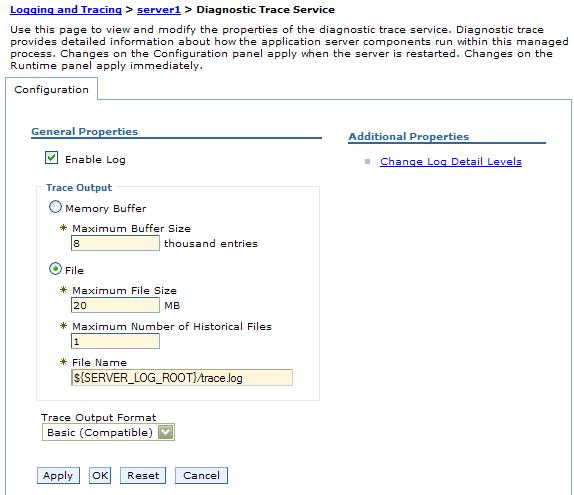Diagnostic trace service settings
Troubleshooting | Logs and Trace | server | Diagnostic trace

Configuration tab
- Enable Log
-
Enables the log service.
If this option is not selected, the following configuration properties are not passed to the appserver trace service at server startup.
- Trace Output
-
Specify where trace output should be written. The trace output can be written directly to an output file, or stored in memory and written to a file on demand using the Dump button found on the run-time page.
Different components can produce different amounts of trace output per entry. Naming and security tracing, for example, produces a much higher trace output than Web container tracing. Consider the type of data being collected when you configure your memory allocation and output settings.
Memory Buffer Specifies that the trace output should be written to an in-memory circular buffer. If you select this option specify the following parameters:
- Maximum Buffer Size
- Specifies the number of entries, in thousands, that can be cached in the buffer. When this number is exceeded, older entries are overwritten by new entries.
- Dump File Name
- The name of the file to which the memory buffer will be written when it is dumped. This option is only available from the Runtime tab.
File
Specifies to write the trace output to a self-managing log file. The self-managing log file writes messages to the file until the specified maximum file size is reached. When the file reaches the specified size, logging is temporarily suspended and the log file is closed and renamed. The new name is based on the original name of the file, plus a timestamp qualifier that indicates when the renaming occurred. Once the renaming is complete, a new, empty log file with the original name is reopened, and logging resumes. No messages are lost as a result of the rollover, although a single message may be split across the two files. If you select this option specify the following parameters:
- Maximum File Size
- Specifies the maximum size, in megabytes, to which the output file is allowed to grow. This attribute is only valid if the File Size attribute is selected. When the file reaches this size, it is rolled over as described above.
- Maximum Number of Historical Files
- Specifies the maximum number of rolled over files to keep.
- File Name
- Specifies the name of the file to which the trace output is written.
- Maximum Buffer Size
- Trace Output Format
-
Format of the trace output. You can specify one of three levels for trace output:
- Basic (Compatible)
- Preserves only basic trace information. Select this option to minimize the amount of space taken up by the trace output.
- Advanced
- Preserves more specific trace information. Select this option to see detailed trace information for use in troubleshooting and problem determination.
- Log analyzer trace format
- Preserves trace information in the same format as produced by Showlog tool.
- Basic (Compatible)
- Runtime tab
-
Format of the trace output.
Save changes to configuration
Save changes made on the runtime tab to the trace configuration as well. Select this box to copy run-time trace changes to the trace configuration settings as well. Saving these changes to the trace configuration will cause the changes to persist even if the application is restarted.
- Trace Output
-
Specify where trace output should be written. The trace output can be written directly to an output file, or stored in memory and written to a file on demand using the Dump button found on the run-time page.
Memory Buffer Specifies that the trace output should be written to an in-memory circular buffer. If you select this option specify the following parameters:
- Maximum Buffer Size
- Specifies the number of entries, in thousands, that can be cached in the buffer. When this number is exceeded, older entries are overwritten by new entries.
- Dump File Name
- The name of the file to which the memory buffer will be written when it is dumped. This option is only available from the Runtime tab.
File
Specifies to write the trace output to a self-managing log file. The self-managing log file writes messages to the file until the specified maximum file size is reached. When the file reaches the specified size, logging is temporarily suspended and the log file is closed and renamed. The new name is based on the original name of the file, plus a timestamp qualifier that indicates when the renaming occurred. Once the renaming is complete, a new, empty log file with the original name is reopened, and logging resumes. No messages are lost as a result of the rollover, although a single message may be split across the two files. If you select this option specify the following parameters:
- Maximum File Size
- Specifies the maximum size, in megabytes, to which the output file is allowed to grow. This attribute is only valid if the File Size attribute is selected. When the file reaches this size, it is rolled over as described above.
- Maximum Number of Historical Files
- Specifies the maximum number of rolled over files to keep.
- File Name
- Specifies the name of the file to which the trace output is written.
- File Name
- View the file that is specified by the File Name parameter. This does not apply the configuration.
- Maximum Buffer Size
Related tasks
Work with trace